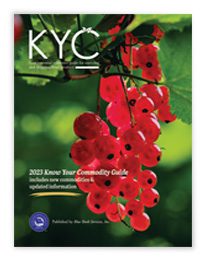Kale Market Summary


Image: Kaiskynet Studio/Shutterstock.com
Kale Market Overview
Although kale has been cultivated since the ancient Greeks and Romans, it has taken the world by storm the last two decades. A cruciferous vegetable, it has also been called leaf cabbage, and belongs to the Brassica oleracea family of cabbage, cauliflower, broccoli, bok choy, collard greens, and Brussels sprouts. Believed to be native to the Mediterranean region, cold hardy kale was a staple in European diets for centuries before arriving in North America as late as the nineteenth century. In the United States, California leads production with Georgia, New Jersey, and Texas contributing to national supply. In Canada, Ontario and Nova Scotia are among the provinces with commercial production. China leads international production. Originally a garnish, kale is now part of salads, soups, smoothies, and made into healthy snacks like chips. Low in calories, kale has no cholesterol or fat, is packed with nutrients (including vitamins A, C, K, and B6) and has been linked to disease prevention. It is considered a “superfood” and earned its own annual holiday: National Kale Day is October 2.
Types & Varieties of Kale
Classified as a leafy green, kale has either flat and smooth or curly/crinkled leaves. Colors range from green and bluish grey to red and deep purple. It is grown as food and an ornamental plant. Green curly kale and Lacinato kale (also known as Tuscan or “dinosaur” kale for its bumpy leaves) are the most common in grocery stores, but other types include Blue Ridge, Redbor, Red Russian, Scotch, Siberian, Vates, and Winterbor. Dwarf varieties and baby kale continue to grow in popularity. Because of its tolerance for cold, kale can flourish anywhere with a cool growing season. Cold spells and frost are beneficial, as the latter will result in a sweeter, less bitter taste.

The Cultivation of Kale
Kale is a relatively easy crop to grow, with planting in the cooler months of spring and fall. Average temperatures from 60 to 65°F are ideal, as warmer weather can inhibit growth or cause bolting. Seasons can be extended into early winter with hoophouses or high tunnels. Kale seeds, with ample room between plants, will germinate within 10 days. Seedlings should be thinned to provide for ample sunlight. As plants mature, removal of the outer leaves will stimulate growth and keep the plant producing. The terminal bud and small leaves at the center of the plant should not be removed, as this halts further growth. Kale grows in full sun to partial shade and flourishes in fertile, loamy, well-drained soil with a pH between 6.0 and 7.5. Consistent moisture of about 12 to 14 inches throughout the growing season is optimal. Leaf maturity at harvest will have a direct impact on shelf life. Mature plants are ready to harvest 50 to 90 days after planting, once the leaves are a rich green with a firm texture. If the leaves are too dark or heavy, they will be tough and less flavorful. Discolored, dried, wilted, or slimy leaves should be culled. Kale is generally harvested by hand in bunches.
Pests & Diseases Affecting Kale
Similar to other cruciferous vegetables such as cabbage and collard greens, kale is attractive to a handful of insects. Among the more common are cabbage worms and flea beetles, which cause damage to leaves, while aphids feed on leaf juices, causing discoloration and wilting. Other pests of concern are army worms, cutworms, harlequin bugs, loopers, mites, moths, and root maggots. Kale is also susceptible to diseases such as Alternaria leaf spot, a fungal infection that causes brown and grey spots due to excess moisture, and black rot, which causes leaf stems to turn black and fall off, due to warm, humid conditions. Other diseases include anthracnose, club root, damping off, downy mildew, leaf spot, root-knot nematodes, and white rust.Storage & Packaging of Kale
Once harvested, kale is washed and packed in crates or cartons, often with top icing. Because of its high respiration rate, kale is a highly perishable and should not be stored at length. Shelf life can be extended up to two weeks if kept at 32°F with 90 to 95% relative humidity. References: Colorado State University, Harvard School of Public Health, Oklahoma Cooperative Extension, Texas A&M AgriLife Extension, University of Arkansas Extension, University of Georgia Extension, University of Illinois Extension, USDA.Grades & Good Arrival of Kale
There are two grades for kale: U.S. No. 1 and U.S. Commercial. For U.S. No. 1, kale leaves must consist of one type, be well-trimmed and not stunted, and free from decay and damage caused by yellow or discolored leaves, seedstems, wilting, bud burn, freezing, dirt, disease, insects, or mechanical harm. For U.S. Commercial kale, leaves must meet U.S. No. 1 requirements, though bronze or slightly yellowish coloring on leaf edges is acceptable, provided they are not dried out. Generally speaking, the percentage of defects shown on a timely government inspection certificate should not exceed the percentage of allowable defects, provided: (1) transportation conditions were normal; (2) the USDA or CFIA inspection was timely; and (3) the entire lot was inspected.| U.S. Grade Standards | Days Since Shipment | % of Defects Allowed | Optimum Transit Temp. (°F) |
| 10-1 | 5 4 3 2 1 | 15-3 14-3 13-2 11-1 10-1 | 32° |

